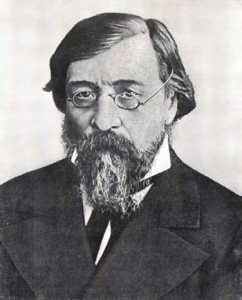On May 19, 1864, the well known journalist and propagandist Nikolai Chernyshevsky was led onto Mytninskaya Square in St. Petersburg, now Chernyshevskaya metro station, to the gallows. He had been found guilty of revolutionary activities and condemned to a “civil execution”. Chernyshevsky (1828-89) was born in Saratov and after studying at a seminary he moved to St. Petersburg in 1846 to study philology at the Philosophy Faculty of St. Petersburg Imperial University where his main revolutionary ideas became established — these were reinforced by the failure of the revolutions that rocked Europe in 1848.
On completing his studies he returned to Saratov where he taught for a couple of years and attempted to instil his pupils with revolutionary ideas. In 1853, he married and relocated to St. Petersburg where he taught for a short period at the 2nd Cadet Corps where he excelled as a lecturer but was forced to resign after a confrontation with an officer. However, by this stage Chernyshevsky was already writing for St. Petersburg papers and in 1854 he began working for the Sovremennik, a liberal journal that had been established in 1836 by the poet Alexander Pushkin. Under Chernyshevsky’s influence the journal was transformed into a revolutionary gazette that was highly critical of the imperial government. In order to avoid the censor, much of the criticism was veiled using discussions of historical events and literary works as a means of discussing the present day problems.
In 1855, he attempted to defend his dissertation at St. Petersburg University on the aesthetic relationship between art and reality in which he caused a furore by claiming that art was of little value. His reasoning followed such lines as: a real apple is more valuable than a picture of an apple because of its practical value, just as a pair of boots is more valuable than the entire works of Pushkin. Such a statement didn’t go down well in Russia’s cultural capital. However, his refutation of aesthetics for realism was well received in some quarters and in 1858, he succeeded in converting a number of military officers to the revolutionary cause. In fact, it was these officers who then became the foundation of the “narodnichestvo” movement, which involved attempts to educate the serfs and working class about the exploitation they suffered under the tsars. This organization later morphed into Narodnya Volya which launched numerous terrorist attacks and succeeded in assassinating Tsar Alexander II in 1881.
Following the emancipation of the serfs with the abolition of the Fortress Law in 1861, Chernyshevsky published three open letters criticizing the reforms for changing the legal status of serfs but not altering the nature of the economic relationship. During this period his writing became increasingly popular among youths in St. Petersburg and it was about this time that Chernyshevsky was put under observation by the secret police. In 1862, he was arrested after a letter was sent to him by the exiled Russian philosopher and founder of Russian realism Alexander Hertsen. Documentation from the police investigation labeled Chernyshevsky as “Imperial Russia’s number one enemy”.
While incarcerated at St. Peter and Paul Fortress, Chernyshevksy wrote his opus magnum, a novel entitled “What is to be done?” in which he refused to follow any rules of aesthetics for its style — making it perhaps one of the worst written books in Russian literature, and heavily criticized by Fedor Dostoevsky for the simplicity of its conclusions. It depicts a utopian society and describes the ideal revolutionary. The work inspired the next generation of revolutionaries, including Vladimir Lenin, and became the basis for Soviet ideology. It is also remarkable in its depiction of women and arguing for equality between the sexes, a principle which he followed in his personal life, making Chernyshevsky one of the world’s first feminists.
Sentenced to a civil execution, Chernyshevsky was marched onto Mytninskaya Square, a wooden sword broken over his head, symbolising his execution of an individual with civil rights. He was then tied to a pillar for several hours, before being sent to Siberia for seven years hard labor. He was to spend the rest of his life in exile, arriving back in his hometown of Saratov only in 1889, shortly before his death. Following the Soviet accession to power, Mytninskaya Square was renamed in honor of Chernyshevsky and when, in the 1950s a metro station was constructed on the site of the civil execution, it took the name of this unusual Soviet hero, with the theme for the decoration of the metro station inspired by the author of “What is to be done?”
This is an extended article of what was first published by The St. Petersburg Times on 28 May 2014.
If you like Intrepid Adventure and our articles, subscribe to our site and share each article in Facebook so that others can enjoy reading them too.
Be sure to like Intrepid Adventure on Facebook and check out Peter Campbell’s latest books on Amazon.com.
Copyright © Peter Campbell 2014, www.intrepid-adventure.com




